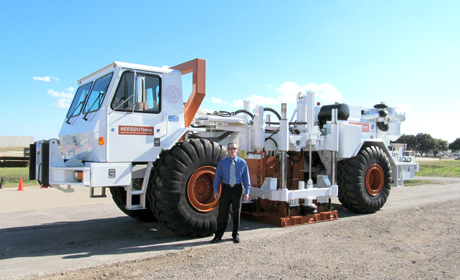 T-Rex, a massive, 64,000-pound shaker truck, is on its way to New Zealand to help earthquake engineers grapple with a seismic challenge following a series of destructive earthquakes that shook its second largest city, Christchurch, in 2011.
T-Rex, a massive, 64,000-pound shaker truck, is on its way to New Zealand to help earthquake engineers grapple with a seismic challenge following a series of destructive earthquakes that shook its second largest city, Christchurch, in 2011.
This earthquake hot spot on New Zealand's south island has one potentially fatal flaw: It's sitting on a bowl of jelly— deep, sandy, swampy sediment on top of bedrock that traps and compounds the earthquake's vibrations. This type of soil can liquefy during an earthquake, losing strength and stiffness, causing buildings to sink into the ground and crack apart.
In late 2012, assistant professor Brady Cox, a civil engineer at The University of Texas at Austin, first traveled to Christchurch where he used strategically placed arrays of seismometers to record ambient soil vibrations (microtremors) in an attempt to profile the deep, soft sediments underlying the city. Now, he will return in mid-March with T-Rex to verify his findings. T-Rex has shaken the ground at sites in the United States, literally from coast to coast, but its trip Down Under will be its first outside the country. T-Rex has already rolled its 5-foot-tall tires onto a cargo ship, Tonsberg v302, at Galveston, Texas, and is expected to arrive in New Zealand in early March.
Cox’s project in Christchurch is one of many with The George E. Brown Jr. Network for Earthquake Engineering Simulation (NEES) a national network and simulation resource, funded by the U.S. National Science Foundation and led by Purdue University. NEES has 14 such sites across the country. NEES at UT Austin, led by Civil Engineering professor Kenneth H. Stokoe II, is the only site with truck-mounted mobile shakers that can be used to simulate earthquake waves. UT Austin's T-Rex is the only known operating tri-axial vibroseis truck in the country.
Watch Brady Cox explain and demonstrate how the shaker truck works.
When it arrives in Christchurch, T-Rex will pound and thud the earth, changing its vibration orientation from vertical to horizontal with the push of a button, in order to generate various seismic waves that are recorded by sophisticated sensors placed along the ground surface. The seismic data gathered with T-Rex will inform engineers, on an area-by-area basis, how to rebuild structures in Christchurch to resist future earthquakes.
"Designing a quake-resistant building starts with the soil," Cox said. "The stiffness and layering of the soil has a profound effect on the strength of shaking felt during an earthquake. The soil stiffness is quantified by a sheer wave velocity, the speed at which waves generated by the earthquake travel through the soil. Soft soils with slow shear wave velocities tend to amplify shaking during an earthquake. Information about the shear wave velocity of the soil is used to inform engineers and government officials about what is needed to design quake-resistant structures in given areas."
Engineers are confident they can design structures that can withstand earthquakes in New Zealand, the U.S. and other places with similar geotechnical challenges. But first, engineers need to know more about the soil in each area. T-Rex can give them that vital information. Then, a foundation and structural system best suited for the particular site and building type can be designed.
The new techniques and experiments that Cox and his team will be running in Christchurch will ultimately be used to characterize earthquake zones in the U.S. with deep, soft soil deposits – areas including the Los Angeles Basin, the Seattle Basin, the Salt Lake Valley and the New Madrid Seismic Zone.
“The information we gather in New Zealand will help us make sure that we are doing everything we need to do in the U.S. We haven’t had a large earthquake in the U.S. in a number of years,” Cox said. “What we learn in Christchurch can be applied to other cities in seismically active areas that haven’t been hit by large earthquakes recently. As earthquake engineers, we have to take the opportunity to learn hard lessons from the past in order to prevent them from happening again in the future.”
Besides losing most of its downtown and several neighborhoods, 185 lives were lost in the Christchurch earthquakes. Additionally, estimates of the economic impact of the Christchurch earthquakes range from $35 billion to $50 billion, approximately a quarter to one-third of the entire gross domestic product for New Zealand.
"I know we can help to prevent this type of damage," he said. "Our hope is that this research will benefit all areas struggling with the threat of earthquakes.”
Cox decided to devote his career to the study of earthquake engineering when he was studying for his master's degree. He was part of a research team that traveled to Turkey in the aftermath of the 1999 earthquake.
"About 18,000 people lost their lives. I saw the devastation and the impact it had on people," Cox said. But Turkey couldn't compare to Haiti, where he was on the scene shortly after the 2010 earthquake.
"It was shocking," Cox said. "More than 300,000 people lost their lives in 45 seconds."
Cox and his team will begin their studies in Christchurch in early March. They are working closely with their colleagues from the University of Canterbury — Misko Curbrinovski and Brendon Bradely — who have been working hard to help Christchurch recover from the aftermath of the earthquakes.
A version of this article was written by Jeanne Norberg of Purdue University.







